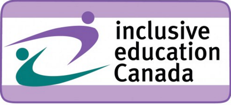National Inclusive Education Month Commentary #7
By Gabrielle Young, PhD
“For most people, technology makes things easier. For people with disabilities, technology makes things possible.” – Mary Pat Radabaugh (2015)
 Children with disabilities may be the most stigmatized and excluded group of children around the world. They are likely to have poorer health, less education, less economic opportunity when they grow up, and are more likely to live in poverty and deal with greater inequalities than their peers without disabilities (WHO, 2015). The lack of access to assistive technology is a major barrier that restricts children with disabilities from accessing education and participating in the community.
Children with disabilities may be the most stigmatized and excluded group of children around the world. They are likely to have poorer health, less education, less economic opportunity when they grow up, and are more likely to live in poverty and deal with greater inequalities than their peers without disabilities (WHO, 2015). The lack of access to assistive technology is a major barrier that restricts children with disabilities from accessing education and participating in the community.
The International Classification of Functioning, Disability and Health defines assistive technology as any product, instrument, equipment or technology adapted or specially designed for improving the functioning of a person with a disability (WHO, 2011). Assistive technology includes products and related services that improve the functioning of people with disabilities. For many children with disabilities, assistive technology means the difference between inclusion and exclusion, between rights enjoyment and rights deprivation (Borj, 2013).
Children with disabilities have lower rates of primary school completion than those without disabilities and in many cases their lack of access to assistive technology is a contributing factor (WHO, 2015). For many children with disabilities, meaningful access to assistive technology is critical for them to access and benefit from education (Alquraini & Gut, 2012), and it can help them to further develop their learning capacity (UNICEF, 2013).
When appropriate to the user and the user’s environment, assistive technology can be a powerful tool to increase a child’s independence and improve their participation (WHO, 2011a; WHO, 2011b). It can help children become mobile, communicate more effectively, see and hear better, and participate more fully in learning and play activities (Netherton & Deal, 2006). In addition, assistive technology supports children to access and enjoy their rights, do things they value, and bridges disparities between children with and without disabilities (Bouck, Flanagan, Miller, & Bassette, 2012; Ground, Lim, & Larsson, 2010; Scherer, 2009; WHO, 2011b).
 Assistive technology provides the means of access to and participation in educational, social and recreational opportunities, empowers greater physical and mental function and improved self-esteem, and reduces costs for educational services and individual supports (Alquraini & Gut, 2012). By facilitating the participation and inclusion of children with disabilities in all aspects of life, assistive technology can have a positive impact on self-image, self-esteem and sense of self-worth (Scherer & Glueckauf, 2005; Scherer, Sax, van Biervliet, Cushman, & Scherer, 2005).
Assistive technology provides the means of access to and participation in educational, social and recreational opportunities, empowers greater physical and mental function and improved self-esteem, and reduces costs for educational services and individual supports (Alquraini & Gut, 2012). By facilitating the participation and inclusion of children with disabilities in all aspects of life, assistive technology can have a positive impact on self-image, self-esteem and sense of self-worth (Scherer & Glueckauf, 2005; Scherer, Sax, van Biervliet, Cushman, & Scherer, 2005).
Assistive technology has been found to improve the achievement of students with disabilities (Parette & Peterson-Karlan, 2007; SIAT, 2013). Assistive technology reduces costs when it supports early childhood development and educational achievement, and avoids repetition of learning that was missed due to educational barriers. The link between school dropout and unemployment is clear, and frequently leads to high costs for society (SIAT, 2013). By improving access to education and increasing achievement in school, assistive technology can have a positive socioeconomic effect on the lives of children with disabilities (Parette & Peterson-Karlan, 2007).
Children with disabilities are more likely to be unemployed and to live in poverty in adulthood than their peers without disabilities (WHO, 2011). An educated child with a disability supported by assistive technology will have greater opportunities for employment (Netherton & Deal, 2006). This results in less dependence on welfare and social security measures, and a greater contribution to the country’s economy and gross domestic product (WHO, 2015). By taking action to address the need for assistive technology, there will be a return on investment that goes beyond an individual family to the larger nation and society in general.
Information and communication tools and applications are paving the way for children with disabilities to access educational materials and resources in different formats and to engage in the same academic activities as their peers without disabilities. Assistive technology offers new ways to break down accessibility barriers and provides children with disabilities with the opportunity to exchange knowledge and information, and to communicate in ways they otherwise may not have been able to do.
References
Alquraini, T., & Gut, D. (2012). Critical components of successful inclusion of students with severe disabilities: Literature review. International Journal of Special Education, 27(1), 42-59.
Borg, J. (2013). Assistive technology for children. In UNICEF (Ed.) The state of the world’s children 2013: Children with disabilities. New York.
Bouck, E. C., Flanagan, S., Miller, B., & Bassette, L. (2012). Rethinking everyday technology as assistive technology to meet students’ IEP goals. Journal of Special Education Technology, 27(4), 47-57.
Ground, A., Lim, N., & Larsson, H. (2010). Effective use of assistive technologies for inclusive education in developing countries: Issues and challenges from two case studies. International Journal of Education & Development using Information & Communication Technology, 6(4), 5-26.
Netherton, D. L., Deal, W. F. (2006). Assistive Technology in the Classroom. Technology Teacher, 66(1), 10-15.
Parette, H. P., & Peterson-Karlan, G. R. (2007). Facilitating student achievement with assistive technology. Education and Training in Developmental Disabilities, 42(4), 387-397.
Radabaugh MP. (2015). Assistive Technology: Independent Living Centre NSW. Available from: https://www.ilcnsw.asn.au/home/assistive_technology/assistive_technology.html Scherer, M. J. (2009). Assistive technology and persons with disabilities. In I. Marini & M. Stebnicki (Eds). Professional counselor desk reference (pp. 735-746). New York: Springer Publishing Co.
Scherer, M. J., & Glueckauf, R. (2005). Assessing the benefits of assistive technologies for activities and participation. Rehabilitation Psychology, 50(2), 132-141. doi: http://dx.doi.org/10.1037/0090-5550.50.2.132
Scherer, M. J., Sax, C., van Biervliet, A., Cushman, L. A., & Scherer, J. V. (2005). Predictors of assistive technology use: The importance of personal and psychosocial factors. Disabil Rehabil, 27(21), 1321-1331. doi: http://dx.doi.org/10.1080/09638280500164800
Swedish Institute of Assistive Technology (SIAT, 2013). Technology support in school. A socioeconomic analysis of youth, failures in school and the labour market. (In Swedish: Teknikstöd i skolan. Socioekonomisk analys av unga, skolmisslyckanden och arbetsmarknaden.). Stockholm.
UNICEF (2013). The state of the world’s children 2013: Children with disabilities. New York: United Nations Children’s Fund. World Health Organization (WHO, 2001). International Classification of Functioning, Disability and Health. Geneva, Switzerland: WHO. Available from http://www.who.int/classifications/icf/en/
World Health Organization (WHO, 2011a). Joint position paper on the provision of mobility devices in less-resourced settings: A step towards implementation of the Convention on the Rights of Persons with Disabilities (CRPD) related to personal mobility. Geneva: World Health Organization.
World Health Organization (WHO, 2011b). World report on disability. Geneva: World Health Organization.
World Health Organization (WHO, 2015). Assistive Technology for Children with Disabilities: Creating Opportunities for Education, Inclusion and Participation. ISBN 978 92 4 150910 7
